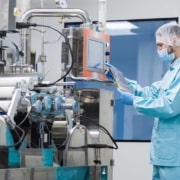Breathe Easier with Single-Use Bronchoscopes.
A bronchoscopy procedure is an endoscopic technique for examining the inner airways of a patient. It is performed for both therapeutic and diagnostic purposes. It involves a thin tube, a bronchoscope, being inserted through the nose or mouth and being fed down the throat into the lungs.
A procedure like this is typically performed to try and find the cause for an issue with the lungs, like a persistent cough or abnormal chest X-ray. This procedure typically has very few complications and, if they do occur, they are usually minor. Symptoms like difficulty swallowing, minor bleeding and fever are common. One of the primary concerns in this type of endoscopy is the risk of infection, and that is what a new study has addressed.
Are Single-Use Bronchoscopes Better Than the Reusable Alternative?
There was a recent study conducted and funded by 3M Company and supported by Healthmark Industries, that tried to assess the cleanliness level of reusable bronchoscopes after they had been cleaned and disinfected. The results of this study are especially vital to note because of the type of patient most often undergoing endoscopy procedures. By and large, patients having this procedure are already at high risk of infection from factors including:
- Organ Transplant Status
- Existing Critical Illness
- Chronic Diseases
- Immune-Suppression due to Malignancy
These risk factors make cleanliness and sterilization one of the primary concerns for any diagnosis or treatment tools. It was previously believed that reusable bronchoscopes would be more cost-effective since they could be sterilized and reused. However, this new study has shown a flaw in this strategy.
How Were These Bronchoscopes Tested?
This particular study was conducted across three large hospitals in the United States, which included two transplant centers. The researchers assessed 24 clinically used flexible tube bronchoscopes after they had been used and cleaned according to each facility’s methods and practices. The study found that all of the bronchoscopes were still contaminated in some way. They found signs of:
- Retained Fluid
- Brown, Red, or Oily Residue
- Scratches
- Damaged Insertion Tubes and Distal Ends
- Filamentous Debris
- Microbial growth, Including Mold
- Stenotrophomonas Maltophilia
- Escherichia Coli/Shigella
It was determined that two out of the three hospitals were using substandard reprocessing methods. However, even when strict guidelines were followed, the high-level disinfection was still not achieved. The results of the study recommended an update in quality management and reprocessing guidelines at all of the testing sites.
Is Single-Use More Cost Effective than Cleaning Reusables?
One recommended, innovative solution for this issue is to simply switch to using single-use plastic bronchoscopes rather than continue to try and sterilize the reusables. According to a 2017 study, it is estimated that reusable bronchoscopes cost $424, and present a 0.7% chance of infection. While single-use technology requires on average $305 and shows a 0.0% risk of infection.
Reusing flexible endoscopes comes with costly hurdles like reprocessing and repairs. Since 2010, there have been steps forward in disposable bronchoscopes, and they have been through multiple generational stages. Each generation came with upgrades to the technology.
- The 2nd generation was optimized for intubating.
- The 3rd generation was focused on bedside bronchoscopy, had a suction channel, and came in three sizes; large, regular, and slim.
- The 4th generation came with better image quality and a more durable design.
To learn more about studies like this and other steps forward in medical device safety, look to Remington Medical. We have been invested in the disposable medical device industry since 1992.









